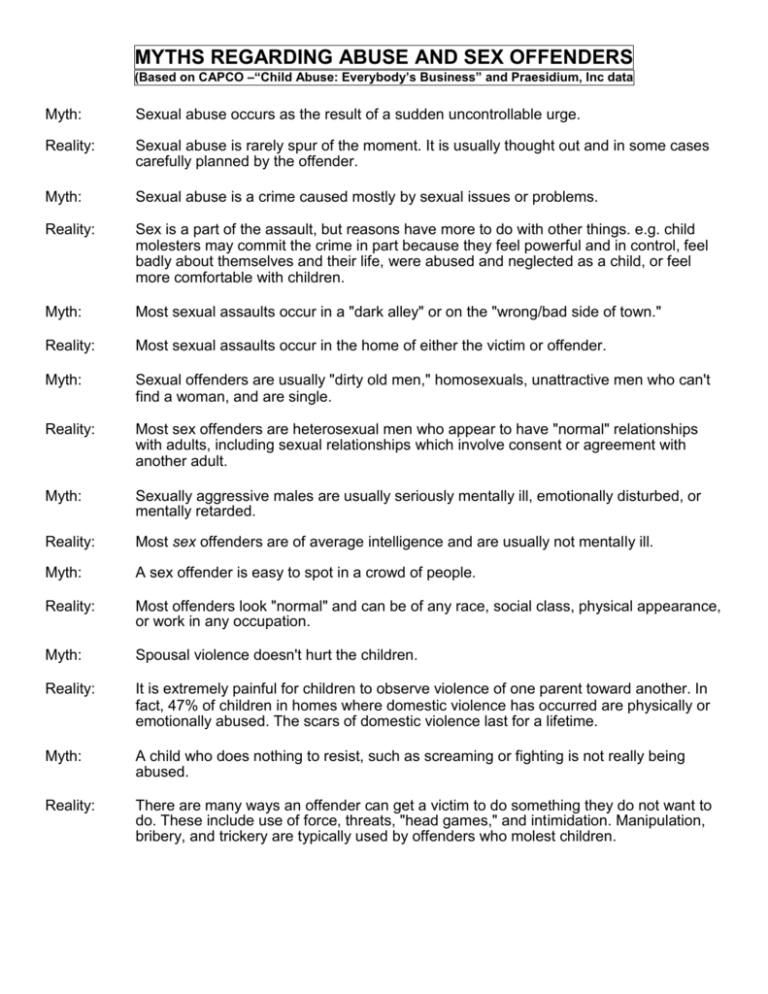
MYTHS REGARDING ABUSE AND SEX OFFENDERS
(Based on CAPCO –“Child Abuse: Everybody’s Business” and Praesidium, Inc data
Myth:
Sexual abuse occurs as the result of a sudden uncontrollable urge.
Reality:
Sexual abuse is rarely spur of the moment. It is usually thought out and in some cases
carefully planned by the offender.
Myth:
Sexual abuse is a crime caused mostly by sexual issues or problems.
Reality:
Sex is a part of the assault, but reasons have more to do with other things. e.g. child
molesters may commit the crime in part because they feel powerful and in control, feel
badly about themselves and their life, were abused and neglected as a child, or feel
more comfortable with children.
Myth:
Most sexual assaults occur in a "dark alley" or on the "wrong/bad side of town."
Reality:
Most sexual assaults occur in the home of either the victim or offender.
Myth:
Sexual offenders are usually "dirty old men," homosexuals, unattractive men who can't
find a woman, and are single.
Reality:
Most sex offenders are heterosexual men who appear to have "normal" relationships
with adults, including sexual relationships which involve consent or agreement with
another adult.
Myth:
Sexually aggressive males are usually seriously mentally ill, emotionally disturbed, or
mentally retarded.
Reality:
Most sex offenders are of average intelligence and are usually not mentally ill.
Myth:
A sex offender is easy to spot in a crowd of people.
Reality:
Most offenders look "normal" and can be of any race, social class, physical appearance,
or work in any occupation.
Myth:
Spousal violence doesn't hurt the children.
Reality:
It is extremely painful for children to observe violence of one parent toward another. In
fact, 47% of children in homes where domestic violence has occurred are physically or
emotionally abused. The scars of domestic violence last for a lifetime.
Myth:
A child who does nothing to resist, such as screaming or fighting is not really being
abused.
Reality:
There are many ways an offender can get a victim to do something they do not want to
do. These include use of force, threats, "head games," and intimidation. Manipulation,
bribery, and trickery are typically used by offenders who molest children.
MYTHS REGARDING ABUSE AND SEX OFFENDERS
(Based on CAPCO –“Child Abuse: Everybody’s Business” and Praesidium, Inc data
Myth:
A large number of sexual abuse accusations are made up by children to get their parent
in trouble.
Reality:
It is very rare for children to fabricate stories of sexual abuse due to the nature of the
allegation and the difficulties faced by the victim after the outcry. Research studies
document that between 2% and 8% of accusations may be fabrications, and that
fabricated allegations are much more likely to be made by adults, usually parents, than
children.
Myth:
Infants, young boys, and men are never sexually abused.
Reality:
Victims range in age from newborn children to the elderly, are of all races and economic
backgrounds, including both male and female. Males are probably victimized almost as
often as females, but male victimization is under-reported.
Myth:
Neglect does not damage children over the long run. As soon as the children grow up
and can take care of themselves, they are okay.
Reality:
Neglect leaves bruises on the soul of children. The fact that basic needs for food,
clothing, shelter, medical care, and love have not been met, leave children with no core
from which to love themselves or others. If these needs are not met in childhood, it is
very difficult for them to be compensated for in later life. Adults who were neglected as
children have a difficult time meeting the needs of their own children because this was
not modeled for them.
Myth:
Many victims are abused because of the way they act or dress.
Reality:
Research illustrates that offenders search for victims who seem like easy targets or who
are probably not going to report them - not because of their behaviors or the style of
their clothes.
Myth:
If a child or young adolescent consents to having sex with an adult, then it cannot really
be considered a sexual assault.
Reality:
Children are not intellectually, socially, or emotionally developed enough to make
decisions regarding sexual activity. A child may cooperate with the offender, but this
does not mean they consent. They often cooperate due to fear, confusion, looking up to
the offender, and other reasons.
Myth:
Strangers are the greatest danger to children.
Reality:
88% of children are abused by someone they know, or to whom they are related.
Myth:
Members of the clergy perpetrate most sexual abuse in churches.
Reality:
Non-clerical employees and volunteers account for more than 80% of sexual abuse
allegations in church and religious organizations. Peers (other minors) account for 8%
and members of the clergy account for 6%.










